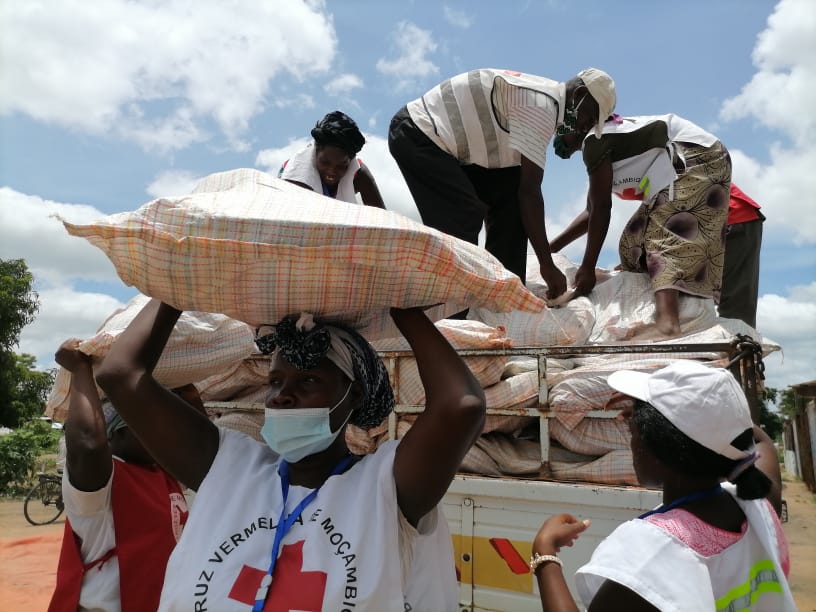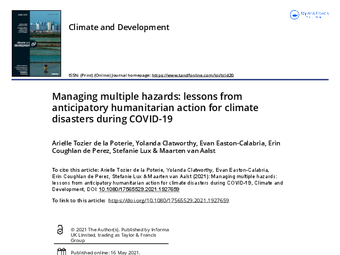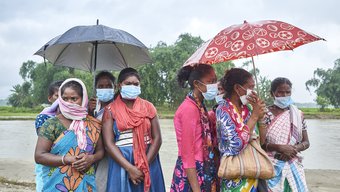Categories
From lessons identified to lessons learned: Applying lessons from COVID-19 to Forecast-based Financing (FbF) operations
There is nothing like an (unanticipated) crisis to help you reassess your activities and encourage you to learn from challenges. While multi-hazard planning has gained increasing interest in recent years, the pandemic presented a unique—though unfortunate—opportunity for organizations around the world to gain some practical experience in multi-hazard management.
So as not to let a learning opportunity go to waste, the Red Cross Red Crescent Climate Centre and the German Red Cross (GRC) commissioned a study of how, if at all, National Societies adjusted their Early Action Protocols (EAPs) to COVID-19 and of what could be learned from their experiences. To that end, my co-authors and I interviewed 23 Red Cross Red Crescent practitioners in 14 countries with EAPs at or near completion. Unsurprisingly, we found that National Societies are willing and able to adapt; as of January 2021, Bangladesh, Mozambique, and Ecuador, had successfully activated their EAPs during the pandemic (Bangladesh twice, one for floods and once for cyclones) despite restrictions in place and the resulting complicating factors for implementation. This was due in large part to trainings and preparation that had already taken place before the pandemic. Despite these accomplishments, we also identified several improvements or changes that might assist practitioners in adapting Early Action to emerging hazards in the future. To find out what drivers of the anticipation agenda within the Red Cross Red Crescent thought about our findings we asked Nazira Lacayo, Senior Officer for Forecast-based Action by the DREF and Stefanie Lux, GRC’s Anticipation Unit Lead for FbF Methodologies and Projects to reflect on our findings via the questions below. For additional background, you can read the full, open-access version of our findings here, or the abstract on this page.
Abstract
In the face of climate change, development and humanitarian practitioners increasingly recognize the need to anticipate and manage multiple, concurrent risks. One prominent example of this increasing focus on anticipation is the rapid growth of Forecast-based Financing (FbF), in particular within Red Cross and Red Crescent (RCRC).
To evaluate how anticipatory efforts managed multiple compounding risks during the COVID-19 pandemic, we examine how 14 RCRC Societies adapted their Early Action Protocols to COVID-19. Though many National Societies successfully adapted to the onset of the additional hazard of COVID-19, we find that multi-hazard risk management can be improved by: proactively developing guidelines that enable rapid adaptation of existing plans; more flexible funding mechanisms; surge capacity to provide additional human resources; and increasing local capacity and ownership for implementation to ensure supplies, skills, and decision-making authority are available when communication or travel is restricted.
These findings align with wider recommendations for improving development, humanitarian, and climate adaptation practice towards local capacity and agency. They also add urgency to broader calls for more flexible disaster financing and more practitioner-oriented investment in climate risk and multi-hazard management.
On hazard information:
Our study found that clear centralized information outlining what needed to be done to reduce COVID-19 transmission was key to modifying EAPs. While it is impossible to document all the ways in which one hazard could affect response to another, what could or is being done to ensure that practitioners have the key information they need for less visible, smaller-scale hazards?
Stefanie:
"Under the umbrella of the Anticipation Hub, in close cooperation with other National Societies, IFRC, and the Climate Centre, we are very much looking into the topic of compounding risk and how to gather and disseminate lessons and experiences as well as how to facilitate exchange between experts through working groups etc.. At the end of this process, we hope to be able to provide guidance to National Societies implementing FbF on how to address compounding risks when different hazards coincide. This guidance could be per (additional) hazard, but it would of course then need to be adapted to the country context, as there are not so many hazards where uniform guidance on risk reduction (as in the case of COVID-19) could be applied."
Nazira:
"What I would like to highlight, is that COVID-19 made us think of compounding risk. We need to do more risk analysis for operations. This is something we already see a lot in the traditional DREF. We are more and more promoting the National Societies to think, “what are the additional risks for the implementation of this operation and how we will we deal with that?” This is an area that can be strengthened in the EAP as they are focused on one scenario. The COVID-19 pandemic showed that we need to consider what to do if the scenario does not play out as we have planned or if we have compounding risks that threaten or change the way we normally operate. The whole system must be able to adapt and deal with that. During the last year, when we go through the EAP validation process we have asked National Societies to explain how they are going to deal with COVID-19 for each EAP, because that is the current topic, but we are also increasingly asking them how they would deal with multiple disaster impacts at the same time. There has been a change in mentality in that respect."
On clearer policies:
Practitioners were not always clear on how, if at all to go about formally modifying their EAPs. How have you incorporated this feedback into plans for future communications?
Stefanie:
"Guidance for National Societies with EAPs would have been available for those who requested it; however, there were problems in communicating those messages in some instances. IFRC has since discussed this internally to improve communication in the future and has put the guidance in writing. As GRC, we will also work with the National Societies we support through FbF projects with to see how EAPs can and need to be adapted and to strengthen capacities in this regard."
Nazira:
"In most cases, the EAPs were still quite new when COVID-19 hit. Most National Societies had just finished the process, so they were still unfamiliar with it. They had only gone through one submission rather than repeated submissions, as with the DREF, where they know how to make updates to their plans because they have been doing the process for so many years. For the DREF, when you change the plan, you issue an operational update explaining, “this is what is happening, and this is the change.”
We have since realized—it was correctly pointed out—that there was not an equivalent to operational updates for FbA by the DREF; it was not clearly defined in the procedures how to do it. As a result, National Societies did not know if the process would be long or short and, being overwhelmed with COVID-19 like the rest of the world, many did not do it.
Since then, IFRC has discussed this with our Delegations and has added sections on how to submit changes and the processes by which they will be approved to the official FbA by the DREF guidance. We now have new processes and the equivalent of an operational update. Mozambique, for example, used this when they wanted to extend the timeline of their post-activation Monitoring and Evaluation activities. It was a good recommendation that has been taken into consideration, and as we move past the pilot phase and into a complete review of FbA by the DREF, it will be taken into further consideration."

On flexibility:
Adapting existing plans requires the ability to adjust activities and budgets. A common complaint about EAPs is that the development process is lengthy and rigid. We found that practitioners were intimidated by even the idea of making revisions. We understand this is because all parties need to be clear on how money can be spent. Have you identified any modifications that might make EAPs more flexible without compromising their rigor?
Stefanie:
"EAPs require stakeholders to accept a higher-level of uncertainty than many other programs. For this reason, we need to clearly explain when we think the probability of an event is high enough to act, which forecasts will be used, how reliable those forecasts are, and what actions will be implemented (and why). The EAPs need to answer these questions, and the process to get all these answers can take a while. Once an EAP is approved, it is valid for 5 years and once a trigger is reached, the funding is allocated automatically without further questions being asked. After an activation, a National Society only needs to submit revisions, not a completely new EAP. Seen in this light, the work invested does pay off.
The EAP-development process varies from country to country. What takes time is not only the development of the EAP, but the active involvement of communities, authorities, and stakeholders in the process. Perhaps most importantly, it takes time to get all the procedures and systems in place to be able to implement early actions in the few days between the forecast and an extreme event wherever forecasts indicate the risk is highest. A lot of the complaints were not linked to the EAP development process as such, but also to processes for having agreements signed etc. Here all organisations involved need to work on their processes. That said, of course, we take complaints regarding EAP development seriously. I know IFRC has recently done a review of the first phase of the FbA by the DREF and is now looking into how to address the recommendations.
All in all, the activations in 2020 show how this prior investment pays off. In the midst of the pandemic the attention of donors but also humanitarian actors was on COVID-19, it was thanks to the EAPs, and with them all the funding, plans, and roles and responsibilities being in place, that National Societies could respond to extreme weather, even when their resources were tied by COVID-19 and there was little capacity at that time to develop proposals or plans for extreme weather."
Nazira:
"Debating or changing plans is normal, natural. It is what you would expect. Things rarely play out as they were initially planned, and we have tried to adapt to that as well. For example, we have tried to reassure National Societies that if they have modifications to make, if they are substantiated by evidence and need, they will be approved. We already have two cases where this has happened. In Mozambique, we were asked to let the National Society activate at a lower threshold. They provided evidence as to why the change was needed, and it was quickly approved. Then in Bangladesh, when they activated their cyclone EAP, the forecast they received from the Bangladesh Met Agency was not providing the information they needed. They asked if they could use forecasts from the Indian Meteorological Service instead. In both cases, the validation committee was consulted, and we gave the green light to activate based on these changes. These were fast changes; I’m talking a matter of hours. This shows that flexibility is possible when it can be substantiated.
At the same time, the plan (the EAP) cannot be dismissed. The plan allows us to gather support for anticipatory action so that governments are on board, the donors are on board, and most importantly, the people who will be targeted know that we are acting on pre-throughout plans that are based on evidence. The balance between plan and flexibility is important, especially because of accountability. These humanitarian actions will have repercussions for people’s lives, so planning is important. We hope that the review of the pilot phase will provide additional alternatives to allow National Societies some flexibility while keeping the integrity of the desired outcome."

On localization:
Localization is a buzz word in humanitarian and development aid; and there is consensus that the people closest to a crisis should have as much power and resources and possible in trying to address it. Furthermore, our findings show that concurrent hazards have the potential to complicate travel between headquarters and branch offices. Given varying National Society and branch capacities and what can be done to ensure that National Societies and their branches have the capacity to activate wherever a threat emerges?
Stefanie:
"The process between starting on FbF and activating an EAP can appear quite long, and that is largely because it involves a lot of work on building capacities, systems, procedures etc. along the way. In all our projects there is a major investment in capacity strengthening to ensure that a National Society can develop, implement, and maintain EAPs at the different levels. The activations in 2020 showed the success of our strong focus on strengthening National Societies’ implementation and response capacities—both at the headquarters and the branch level. In Bangladesh and the Philippines, branches were able to act even when staff from the project office in the capital could not travel. They knew what to do due to previous trainings, simulations, and appropriate procedures being in place. The Red Cross Red Crescent’s investment in National Societies as local actors implementing enables us to implement anywhere in country and sets us apart from other approaches to anticipation. Our FbF work does not only focus on funding the early actions or supporting the development of EAPs. It really includes an element of building systems and mechanisms to ensure that everything is in place so that National Societies can act when triggers are reached and update and maintain EAPs. Of course, we have not reached all branches yet, but with time we hope that more branches will be able to implement without much assistance from their headquarters."
Nazira:
"For me, this is very operational and connected to the bigger picture of National Society sustainability and financial capacity. Time-bound programmatic support should be aligned with National Society development plans to achieve long-term sustainability. Financial sustainability is key to achieving overall capacity, not only for early action, but for response as well. In the end, there are not specific capacities only for early action. We know that the ability of the National Society to deliver on their core services and on their emergency response are linked—the same people and performing both services. It all comes back the National Societies ability to resource their needs."
This blog was written by Arielle Tozier de la Poterie, PhD., Global advisor Early Action and Research, German Red Cross



